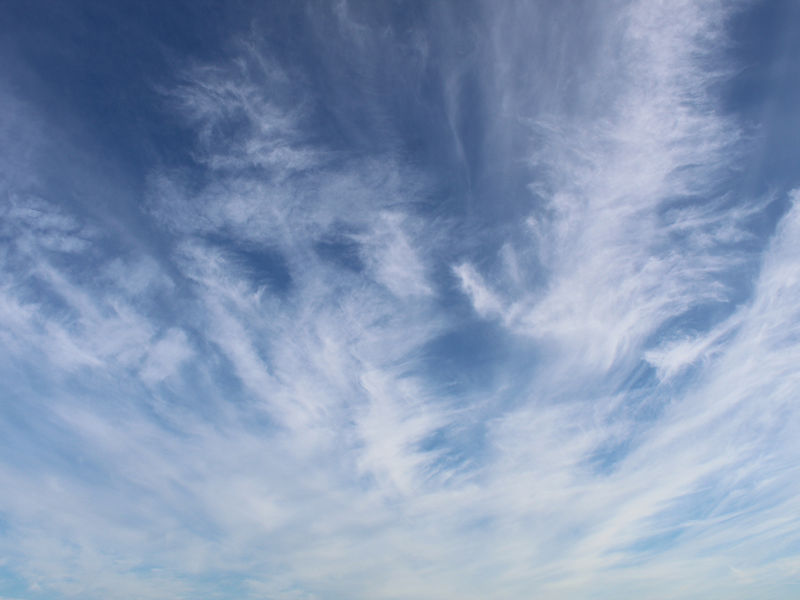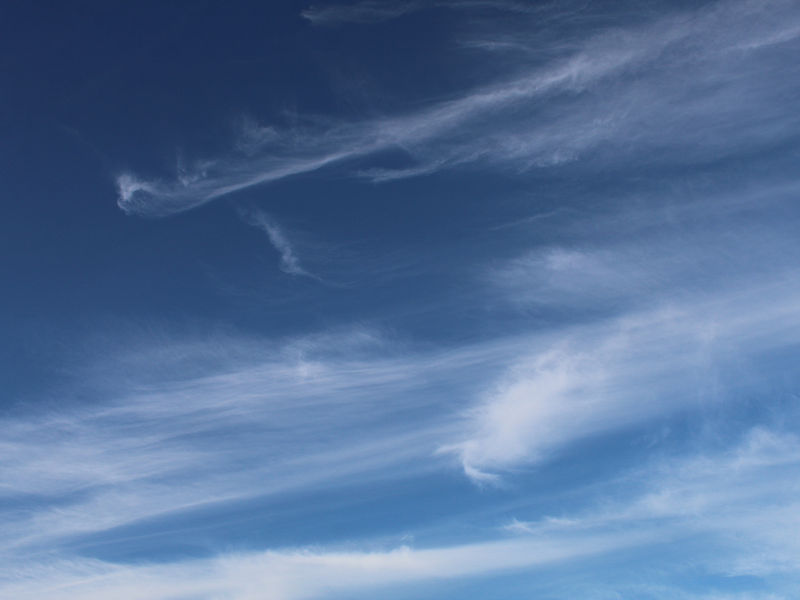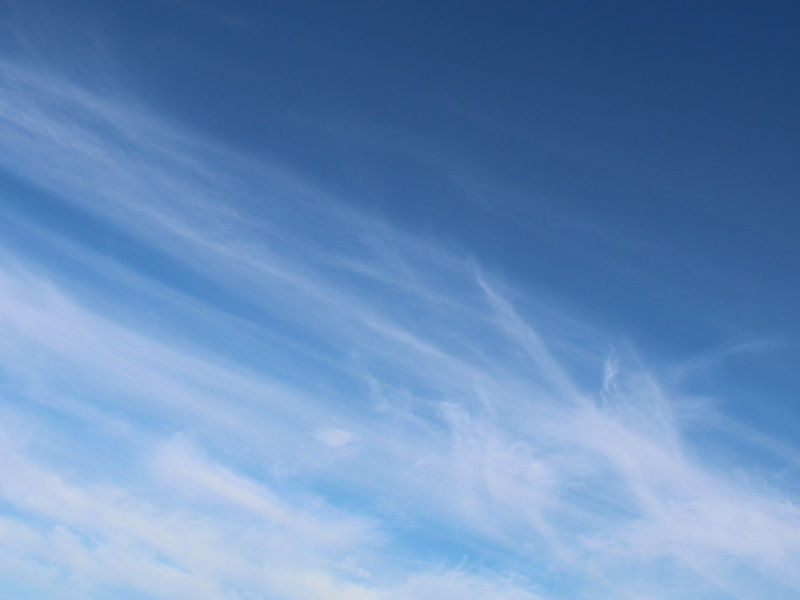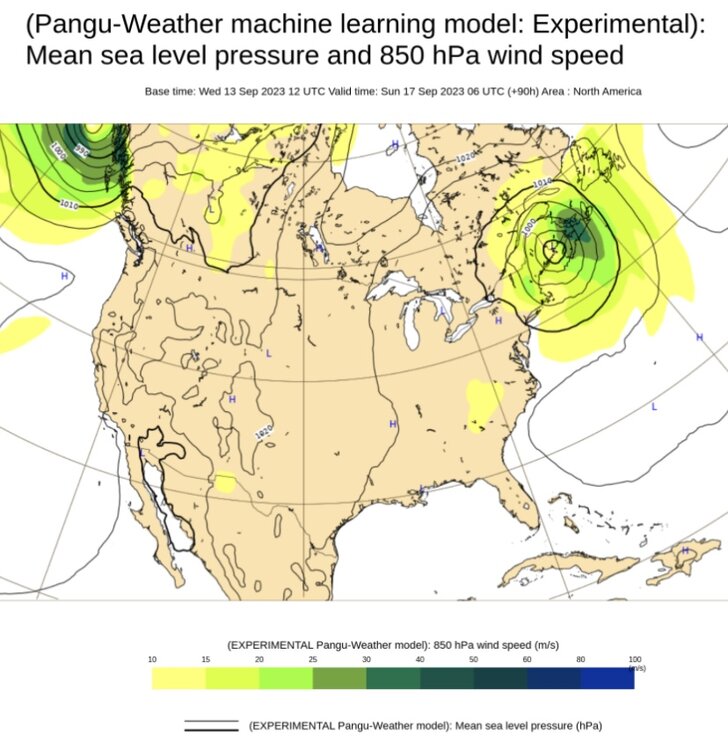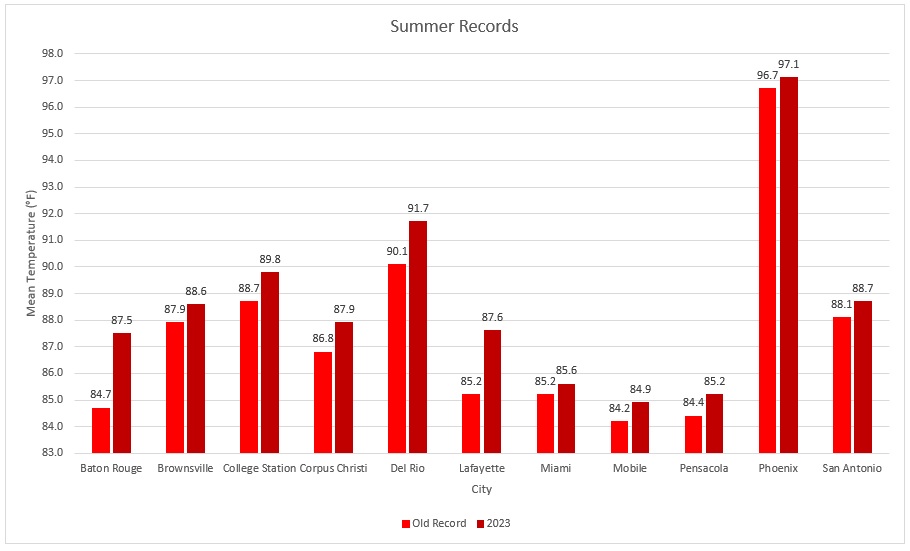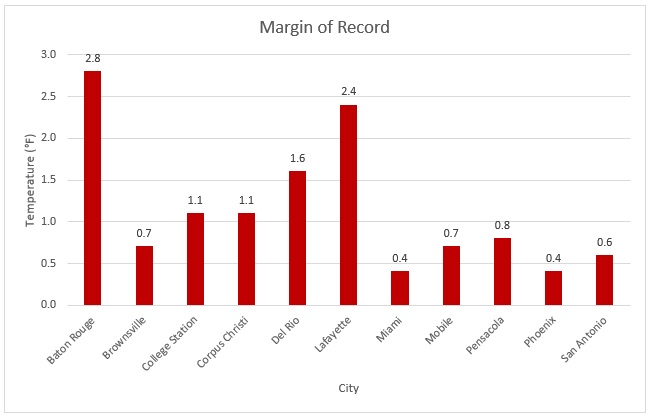-
Posts
22,981 -
Joined
Content Type
Profiles
Blogs
Forums
American Weather
Media Demo
Store
Gallery
Everything posted by donsutherland1
-
Tomorrow will be fair and pleasant. However, rain will arrive on Monday and continue into Tuesday. A general 0.50"-1.50" of rain is likely. In the medium and longer range, a warmer than normal pattern could develop in eastern North America. The ENSO Region 1+2 anomaly was +2.9°C and the Region 3.4 anomaly was +1.6°C for the week centered around September 6. For the past six weeks, the ENSO Region 1+2 anomaly has averaged +3.20°C and the ENSO Region 3.4 anomaly has averaged +1.38°C. El Niño conditions will likely continue to strengthen into the fall with the current East-based event transitioning to a basinwide El Niño for the upcoming winter. The SOI was -13.19 today. The preliminary Arctic Oscillation (AO) was -0.786 today. On September 13 the MJO was in Phase 4 at an amplitude of 1.663 (RMM). The September 12-adjusted amplitude was 1.721 (RMM). Based on sensitivity analysis applied to the latest guidance, there is an implied 81% probability that New York City will have a warmer than normal September (1991-2020 normal). September will likely finish with a mean temperature near 71.5° (2.3° above normal).
-
After a chilly start, temperatures rose into the upper 60s and lower 70s across much of the region. Tomorrow will then be fair and continued cool. Much of the region will likely see temperatures top out in the lower to middle 70s. In the medium and longer range, a warmer than normal pattern could develop in eastern North America. The ENSO Region 1+2 anomaly was +2.9°C and the Region 3.4 anomaly was +1.6°C for the week centered around September 6. For the past six weeks, the ENSO Region 1+2 anomaly has averaged +3.20°C and the ENSO Region 3.4 anomaly has averaged +1.38°C. El Niño conditions will likely continue to strengthen into the fall with the current East-based event transitioning to a basinwide El Niño for the upcoming winter. The SOI was -16.99 today. The preliminary Arctic Oscillation (AO) was -0.613 today. On September 12 the MJO was in Phase 4 at an amplitude of 1.721 (RMM). The September 11-adjusted amplitude was 2.188 (RMM). Based on sensitivity analysis applied to the latest guidance, there is an implied 80% probability that New York City will have a warmer than normal September (1991-2020 normal). September will likely finish with a mean temperature near 71.5° (2.3° above normal).
-
Tonight could be the coolest night so far in many areas in the northern Mid-Atlantic area. Readings in New York City could dip below 60° for the first time this fall. Temperatures in the suburbs will fall into the lower and middle 50s. Some of the more distant or colder suburbs could see temperatures drop into the 40s. Tomorrow will then be fair but unseasonably cool. Much of the region will likely see temperatures top out in the upper 60s and lower 70s. Hurricane Lee will streadily move toward North American landfall. The guidance favors landfall in New Brunswick, but landfall along the Maine or Nova Scotia coast cannot be ruled out. Eastern Long Island and eastern New England could some periods of heavy rain and gusty winds as Lee passes offshore. The ENSO Region 1+2 anomaly was +2.9°C and the Region 3.4 anomaly was +1.6°C for the week centered around September 6. For the past six weeks, the ENSO Region 1+2 anomaly has averaged +3.20°C and the ENSO Region 3.4 anomaly has averaged +1.38°C. El Niño conditions will likely continue to strengthen into the fall with the current East-based event transitioning to a basinwide El Niño for the upcoming winter. The SOI was -13.37 today. The preliminary Arctic Oscillation (AO) was +0.113 today. On September 12 the MJO was not available. The September 11-adjusted amplitude was 2.188 (RMM). Based on sensitivity analysis applied to the latest guidance, there is an implied 81% probability that New York City will have a warmer than normal September (1991-2020 normal). September will likely finish with a mean temperature near 71.6° (2.4° above normal).
-
In the wake of a cold frontal passage, some of the coolest temperatures so far this fall are likely. Most areas outside of New York City and Philadelphia will see lows in the 50s and highs in the 70s through Friday. New York City could even experience its first sub-60° low temperature of this fall. Hurricane Lee will remain a powerful storm over the next several days. The guidance favors landfall in New Brunswick, but landfall along the Maine or Nova Scotia coast cannot be ruled out. Eastern Long Island and eastern New England could some periods of heavy rain and gusty winds as Lee passes offshore. The ENSO Region 1+2 anomaly was +2.9°C and the Region 3.4 anomaly was +1.6°C for the week centered around September 6. For the past six weeks, the ENSO Region 1+2 anomaly has averaged +3.20°C and the ENSO Region 3.4 anomaly has averaged +1.38°C. El Niño conditions will likely continue to strengthen into the fall with the current East-based event transitioning to a basinwide El Niño for the upcoming winter. The SOI was -15.63 today. The preliminary Arctic Oscillation (AO) was +0.502 today. On September 11 the MJO was in Phase 4 at an amplitude of 2.188 (RMM). The September 10-adjusted amplitude was 2.213 (RMM). Based on sensitivity analysis applied to the latest guidance, there is an implied 77% probability that New York City will have a warmer than normal September (1991-2020 normal). September will likely finish with a mean temperature near 71.5° (2.3° above normal).
-
-
A strong cold front will cross the region tomorrow with some heavy thunderstorms. Parts of the region could experience street and highway flooding as excessive rainfall amounts are possible. Behind the front, some of the coolest temperatures so far this fall are likely. Hurricane Lee will remain a powerful storm over the next several days. Atlantic Canada faces the highest risk of landfall, but New England landfall still cannot completely be ruled out. The ECMWF offers the farthest west track on the operational guidance. Eastern Long Island and eastern New England could experience heavy rains and high winds as Lee passes offshore. The ENSO Region 1+2 anomaly was +2.9°C and the Region 3.4 anomaly was +1.6°C for the week centered around September 6. For the past six weeks, the ENSO Region 1+2 anomaly has averaged +3.20°C and the ENSO Region 3.4 anomaly has averaged +1.38°C. El Niño conditions will likely continue to strengthen into the fall with the current East-based event transitioning to a basinwide El Niño for the upcoming winter. The SOI was -24.06 today. The preliminary Arctic Oscillation (AO) was +0.438 today. On September 10 the MJO was in Phase 4 at an amplitude of 2.211 (RMM). The September 9-adjusted amplitude was 2.506 (RMM). Based on sensitivity analysis applied to the latest guidance, there is an implied 78% probability that New York City will have a warmer than normal September (1991-2020 normal). September will likely finish with a mean temperature near 71.5° (2.3° above normal).
-
Slow-moving thunderstorms brought torrential downpours to parts of the region producing flash flooding. Greenwich, NJ picked up 5.00" of rain this afternoon. Tomorrow will be a quieter day. It will be partly to mostly sunny and pleasant. Only a few isolated showers or thundershowers are possible. Most of the region should be dry. A strong cold front will cross the region on Wednesday with some heavy thunderstorms. Some street and highway flooding is possible. Behind it, parts of the region could see their coolest temperatures so far this fall. Hurricane Lee will remain a powerful storm over the next several days. Atlantic Canada faces the highest risk of landfall, but New England landfall still cannot completely be ruled out. Moreover, parts of eastern New England could experience heavy rains and high winds as Lee passes offshore. The ENSO Region 1+2 anomaly was +2.9°C and the Region 3.4 anomaly was +1.6°C for the week centered around September 6. For the past six weeks, the ENSO Region 1+2 anomaly has averaged +3.20°C and the ENSO Region 3.4 anomaly has averaged +1.38°C. El Niño conditions will likely continue to strengthen into the fall with the current East-based event transitioning to a basinwide El Niño for the upcoming winter. The SOI was -27.45 today. The preliminary Arctic Oscillation (AO) was +0.320 today. On September 9 the MJO was in Phase 4 at an amplitude of 2.507 (RMM). The September 8-adjusted amplitude was 2.511 (RMM). Based on sensitivity analysis applied to the latest guidance, there is an implied 77% probability that New York City will have a warmer than normal September (1991-2020 normal). September will likely finish with a mean temperature near 71.5° (2.3° above normal).
-
A heavy thunderstorm is ongoing in the Bronx.
-

Occasional Thoughts on Climate Change
donsutherland1 replied to donsutherland1's topic in Climate Change
Yes. Unfortunately, some of those earlier records likely overstate the high temperatures. And yet, those records are now being surpassed. -
Some showers and thundershowers will be possible tomorrow. Readings will top out in the upper 70s to perhaps low 80s. A strong cold front will cross the region on Wednesday with some thunderstorms. Behind it, parts of the region could see their coolest temperatures so far this fall. Hurricane Lee will remain a powerful storm over the next several days. Atlantic Canada faces the highest risk of landfall, but New England landfall still cannot completely be ruled out. The picture will clear in coming days. The ECMWF weeklies had forecast temperatures to average above to much above normal across the region for the September 4-11 period. That forecast is verifying with the ongoing heatwave. September has increasingly become an extension of summer in parts of the Northeast. Since 2000, almost half of all years (48%) have had a monthly mean temperature of 70° or above in New York City. Prior to 2000, just 20% of Septembers had mean temperatures of 70° or above. The ENSO Region 1+2 anomaly was +3.2°C and the Region 3.4 anomaly was +1.6°C for the week centered around August 30. For the past six weeks, the ENSO Region 1+2 anomaly has averaged +3.22°C and the ENSO Region 3.4 anomaly has averaged +1.32°C. El Niño conditions will likely continue to strengthen into the fall with the current East-based event transitioning to a basinwide El Niño for the upcoming winter. The SOI was -21.57 today. The preliminary Arctic Oscillation (AO) was +0.283 today. On September 8 the MJO was in Phase 3 at an amplitude of 2.509 (RMM). The September 7-adjusted amplitude was 2.666 (RMM). Based on sensitivity analysis applied to the latest guidance, there is an implied 74% probability that New York City will have a warmer than normal September (1991-2020 normal). September will likely finish with a mean temperature near 71.5° (2.3° above normal).
-
A cooling trend got underway today. Nevertheless, Philadelphia topped out at 91°. That was its 7th consecutive 90° or above day. That set a new September record. The previous record was set during Septembr 5-10, 1884 and tied on September 1-6, 1898 and September 9-14, 1931. The cooling trend will continue into early next week. In addition, showers and thundershowers will be possible tomorrow and Monday. Hurricane Lee will remain a powerful storm. The ensembles favor recurvature, but the outcome is not yet cast in stone. An area running from eastern New England to Atlantic Canada could face the highest risk of landfall should Lee fail to recurve away from the North American continent. The picture should begin to clear in coming days. The ECMWF weeklies had forecast temperatures to average above to much above normal across the region for the September 4-11 period. That forecast is verifying with the ongoing heatwave. September has increasingly become an extension of summer in parts of the Northeast. Since 2000, almost half of all years (48%) have had a monthly mean temperature of 70° or above in New York City. Prior to 2000, just 20% of Septembers had mean temperatures of 70° or above. The ENSO Region 1+2 anomaly was +3.2°C and the Region 3.4 anomaly was +1.6°C for the week centered around August 30. For the past six weeks, the ENSO Region 1+2 anomaly has averaged +3.22°C and the ENSO Region 3.4 anomaly has averaged +1.32°C. El Niño conditions will likely continue to strengthen into the fall with the current East-based event transitioning to a basinwide El Niño for the upcoming winter. The SOI was -19.67 today. The preliminary Arctic Oscillation (AO) was +0.527 today. On September 7 the MJO was in Phase 3 at an amplitude of 2.665 (RMM). The September 6-djusted amplitude was 2.560 (RMM). Based on sensitivity analysis applied to the latest guidance, there is an implied 76% probability that New York City will have a warmer than normal September (1991-2020 normal). September will likely finish with a mean temperature near 71.6° (2.4° above normal).
-
Parts of the region, including New York City, reached 90° today. However, cooler weather will be moving into the region. That cooling trend will continue through the weekend and into early next week. In addition, showers and thundershowers will be possible tomorrow and Sunday. Hurricane Lee will remain a powerful storm. The ensembles favor recurvature, but the outcome is not yet cast in stone. An area running from eastern New England to Atlantic Canada could face the highest risk of landfall should Lee fail to recurve away from the North American continent. The picture should begin to clear during the weekend into early next week. The ECMWF weeklies had forecast temperatures to average above to much above normal across the region for the September 4-11 period. That forecast is verifying with the ongoing heatwave. September has increasingly become an extension of summer in parts of the Northeast. Since 2000, almost half of all years (48%) have had a monthly mean temperature of 70° or above in New York City. Prior to 2000, just 20% of Septembers had mean temperatures of 70° or above. The ENSO Region 1+2 anomaly was +3.2°C and the Region 3.4 anomaly was +1.6°C for the week centered around August 30. For the past six weeks, the ENSO Region 1+2 anomaly has averaged +3.22°C and the ENSO Region 3.4 anomaly has averaged +1.32°C. El Niño conditions will likely continue to strengthen into the fall with the current East-based event transitioning to a basinwide El Niño for the upcoming winter. The SOI was -3.03 today. The preliminary Arctic Oscillation (AO) was +0.934 today. On September 6 the MJO was in Phase 3 at an amplitude of 2.602 (RMM). The September 5-djusted amplitude was 2.200 (RMM). Based on sensitivity analysis applied to the latest guidance, there is an implied 76% probability that New York City will have a warmer than normal September (1991-2020 normal). September will likely finish with a mean temperature near 71.6° (2.4° above normal).
-
Today was another day of extreme heat in parts of the East. Highs included: Albany: 93° Allentown: 92° (old record: 91°, 1985, 2015 and 2016) Atlantic City: 93° Baltimore: 98° (first September heatwave with 5 or more 98° days) Boston: 93° Bridgeport: 92° (old record: 91°, 1983) Concord: 93° Harrisburg: 94° Hartford: 95° (old record: 93°, 2007 and 2015) Islip: 92° (tied record set in 1998) New Haven: 95° (old record: 85°, 2015) ***New September Record*** New York City-Central Park: 93° New York City-JFK Airport: 92° New York City-LaGuardia Airport: 96° (old record: 90°, 1945 and 2015) Norfolk: 96° Philadelphia: 97° Providence: 92° Richmond: 100° ***2nd 100° high this month for the first time since 1954*** Sterling, VA: 97° (old record: 95°, 1983 and 1985) Washington, DC: 98° Wilmington, DE: 93° Worcester: 90° (tied record set in 1901 and tied in 1945) A cooling trend should commence tomorrow and continue through the weekend. Dangerous Hurricane Lee will likely grow into a Category 5 storm tonight or tomorrow. The ensembles favor recurvature, but the outcome is not yet cast in stone. An area running from eastern New England to Atlantic Canada could face the highest risk of landfall should Lee fail to recurve away from the North American continent. The ECMWF weeklies had forecast temperatures to average above to much above normal across the region for the September 4-11 period. That forecast is verifying with the ongoing heatwave. September has increasingly become an extension of summer in parts of the Northeast. Since 2000, almost half of all years (48%) have had a monthly mean temperature of 70° or above in New York City. Prior to 2000, just 20% of Septembers had mean temperatures of 70° or above. The ENSO Region 1+2 anomaly was +3.2°C and the Region 3.4 anomaly was +1.6°C for the week centered around August 30. For the past six weeks, the ENSO Region 1+2 anomaly has averaged +3.22°C and the ENSO Region 3.4 anomaly has averaged +1.32°C. El Niño conditions will likely continue to strengthen into the fall with the current East-based event transitioning to a basinwide El Niño for the upcoming winter. The SOI was -3.03 today. The preliminary Arctic Oscillation (AO) was +0.706 today. On September 4 he MJO was in Phase 3 at an amplitude of 1.585 (RMM). The September 3-djusted amplitude was 1.091 (RMM). Based on sensitivity analysis applied to the latest guidance, there is an implied 73% probability that New York City will have a warmer than normal September (1991-2020 normal). September will likely finish with a mean temperature near 71.5° (2.3° above normal).
-
This morning's low temperature at LaGuardia Airport was 80°. If that low holds, it would be the latest 80° or above low on record for the New York City area (Central Park, JFK Airport, or LaGuardia Airport). The record is September 4, 2018 at LaGuardia Airport.
-
Today was another blazing hot day. Highs included: Albany: 92° (old record: 91°, 1983 and 2018) Allentown: 91° Atlantic City: 97° Baltimore: 100° (old record: 98°, 1983) ***Only the 4th 100° reading on record for September*** Buffalo: 90° Burlington: 92° (old record: 90°, 1945 and 2015) Concord: 92° (tied record set in 2018) Harrisburg: 95° Islip: 92° (old record: 90°1985) Manchester: 93° (tied record set in 2018) New York City-Central Park: 93° New York City-JFK Airport: 93° (old record: 92°, 1985) New York City-LaGuardia Airport: 93° Newark: 97° Norfolk: 93° Philadelphia: 95° (tied record set in 1983 and tied in 2018) Richmond: 101° Scranton: 90° Sterling, VA: 100° (old record: 98°, 1983) ***New September record*** Washington, DC: 98° (tied record set in 1954) Wilmington, DE: 94° Tomorrow will be generally fair and hot with temperatures reaching the upper 80s and lower 90s well into New England. Widespread middle and upper 90s are likely in Baltimore, Washington, and Philadelphia. Some locations could experience a thunderstorm. A cooling trend should commence Friday and continue through the weekend. Lee has now become a hurricane. Lee will very likely become a dangerous major hurricane by this weekend. The ensembles favor recurvature, but the outcome is not yet cast in stone. Indeed, some of the guidance has grown stronger with the ridging that could result in increased risk to a portion of the East Coast. The ECMWF weeklies had forecast temperatures to average above to much above normal across the region for the September 4-11 period. That forecast is verifying with the ongoing heatwave. September has increasingly become an extension of summer in parts of the Northeast. Since 2000, almost half of all years (48%) have had a monthly mean temperature of 70° or above in New York City. Prior to 2000, just 20% of Septembers had mean temperatures of 70° or above. The ENSO Region 1+2 anomaly was +3.2°C and the Region 3.4 anomaly was +1.6°C for the week centered around August 30. For the past six weeks, the ENSO Region 1+2 anomaly has averaged +3.22°C and the ENSO Region 3.4 anomaly has averaged +1.32°C. El Niño conditions will likely continue to strengthen into the fall with the current East-based event transitioning to a basinwide El Niño for the upcoming winter. The SOI was unavailable today. The preliminary Arctic Oscillation (AO) was +0.623 today. On September 2 the MJO was in Phase 3 at an amplitude of 0.745 (RMM). The September 1-adjusted amplitude was 0.582 (RMM).
-
Under partly sunny skies, temperatures reached scorching levels into New England. High temperatures in the 90s included: Albany: 91° Allentown: 91° Atlantic City: 94° (old record: 93°, 1985) Baltimore: 99° (old record: 96°, 1954) ***2023 becomes the 1st September with more than one 99° reading*** Bangor: 91° Concord: 92° (old record: 91°, 1953, 1961, and 2018) Harrisburg: 94° (tied record set in 2018) Hartford: 92° Islip: 91° (old record: 90°, 1985) Manchester: 92° New York City-Central Park: 92° New York City-JFK Airport: 93° New York City-LaGuardia Airport: 90° Newark: 95° (old record: 94°, 1961 and 1985) Philadelphia: 94° Richmond: 98° Rochester: 91° Sterling, VA: 99° (old record: 96°, 1985) ***Tied September record for the 3rd consecutive day*** Syracuse: 90° Washington, DC: 99° (old record: 97°, 1881) Wilmington, DE: 92° Tomorrow through Thursday will be generally fair and hot with temperatures reaching the upper 80s and lower 90s well into New England. Widespread upper 90s to around 100° are likely in Baltimore, Washington, and Philadelphia. A cooling trend should commence late in the week and continue through the weekend. Newly-formed Lee will very likely become a major hurricane by this weekend. The ensembles favor recurvature, but the outcome is not yet cast in stone. The ECMWF weeklies had forecast temperatures to average above to much above normal across the region for the September 4-11 period. That forecast is verifying with the ongoing heatwave. September has increasingly become an extension of summer in parts of the Northeast. Since 2000, almost half of all years (48%) have had a monthly mean temperature of 70° or above in New York City. Prior to 2000, just 20% of Septembers had mean temperatures of 70° or above. The ENSO Region 1+2 anomaly was +3.2°C and the Region 3.4 anomaly was +1.6°C for the week centered around August 30. For the past six weeks, the ENSO Region 1+2 anomaly has averaged +3.22°C and the ENSO Region 3.4 anomaly has averaged +1.32°C. El Niño conditions will likely continue to strengthen into the fall with the current East-based event transitioning to a basinwide El Niño for the upcoming winter. The SOI was -2.85 today. The preliminary Arctic Oscillation (AO) was +0.708 today.
-
Much of the Middle Atlantic region roasted under near record and record high temperatures today. The northern Middle Atlantic region and southern New England were somewhat cooler. High temperatures included: Atlantic City: 94° Baltimore: 99° (old record: 96°, 1937 and 2019) ***7th 99° or above temperature on record for September*** Burlington: 90° Harrisburg: 97° (old record: 93°, 1964, 2008, and 2015) Philadelphia: 96° (old record: 93°, 1973, 2008, 2015, 2018) Richmond: 98° (old record: 95°, 1925, 1947, and 1970) Scranton: 92° (tied record set in 1929) Sterling, VA: 99° (old record: 95°, 1985) ***Tied September monthly record*** Trenton: 93° Washington, DC: 98° (old record: 96°, 2019) Wilmington, DE: 96° (old record: 95°, 2018) In the Southwest, El Paso reached 100° for the 63rd day this year. That broke the record of 62 days, which was set in 1994. Tomorrow through Thursday will be generally fair and hot with temperatures reaching the upper 80s and lower 90s well into New England. Middle and upper 90s are likely in Baltimore, Washington, and PHiladelphia. There is a chance that one or more of those cities could reach 100°. A cooling trend should commence late in the week and continue through the weekend. The ECMWF weeklies had forecast temperatures to average above to much above normal across the region for the September 4-11 period. September has increasingly become an extension of summer in parts of the Northeast. Since 2000, almost half of all years (48%) have had a monthly mean temperature of 70° or above in New York City. Prior to 2000, just 20% of Septembers had mean temperatures of 70° or above. The ENSO Region 1+2 anomaly was +3.2°C and the Region 3.4 anomaly was +1.6°C for the week centered around August 30. For the past six weeks, the ENSO Region 1+2 anomaly has averaged +3.22°C and the ENSO Region 3.4 anomaly has averaged +1.32°C. El Niño conditions will likely continue to strengthen into the fall with the current East-based event transitioning to a basinwide El Niño for the upcoming winter. The SOI was -2.85 today. The preliminary Arctic Oscillation (AO) was +1.361 today. On September 1 the MJO was unavailable. The August 31-adjusted amplitude was 0.743 (RMM).
-
A September heatwave is in the early stages of development in the Middle Atlantic region. Today 90° or above temperatures included: Atlantic City: 91° Baltimore: 98° (old record: 97°, 1898) Newark: 92° Philadelphia: 92° Richmond: 96° Sterling, VA: 99° (old record: 96°, 1993) ***Tied September record*** Washington, DC: 97° Wilmington, DE: 93° Labor Day will be fair and hot with temperatures reaching the upper 80s and lower 90s into southern New England. Middle and upper 90s are likely in Baltimore, Washington, and PHiladelphia. There is a chance that one or more of those cities could reach 100°. The ECMWF weeklies suggest that the September 4-11 period could see temperatures average above to much above normal across the region. Parts of the region could see high temperatures peak at or above 90° on one or more days. September has increasingly become an extension of summer in parts of the Northeast. Since 2000, almost half of all years (48%) have had a monthly mean temperature of 70° or above in New York City. Prior to 2000, just 20% of Septembers had mean temperatures of 70° or above. The ENSO Region 1+2 anomaly was +3.1°C and the Region 3.4 anomaly was +1.5°C for the week centered around August 23. For the past six weeks, the ENSO Region 1+2 anomaly has averaged +3.27°C and the ENSO Region 3.4 anomaly has averaged +1.23°C. El Niño conditions will likely continue to strengthen into the fall with the current East-based event transitioning to a basinwide El Niño for the upcoming winter. The SOI was -13.49 today. The preliminary Arctic Oscillation (AO) was +1.898 today. On August 31 the MJO was in Phase 3 at an amplitude of 0.743 (RMM). The August 30-adjusted amplitude was 0.788 (RMM).
-
It would have been. Typo on my part. 51.
-
Meteorological fall commenced with unseasonably chilly readings across the northern Mid-Atlantic and southern New England regions. Low temperatures included: Albany: 512° Binghamton: 49° Boston: 57° Bridgeport: 57° Danbury: 49° Hartford: 51° Islip: 58° New Haven: 55° New York City: 61° Newark: 60° Philadelphia: 62° Poughkeepsie: 47° Providence: 54° Westhampton: 57° White Plains: 53° The Labor Day weekend will start cool but turn noticeably warmer on Sunday. Labor Day will be fair and hot with temperatures reaching the upper 80s and even lower 90s. The ECMWF weeklies suggest that the September 4-18 period could see temperatures average above to much above normal across the region. Parts of the region could see high temperatures peak at or above 90° on one or more days. September has increasingly become an extension of summer in parts of the Northeast. Since 2000, almost half of all years (48%) have had a monthly mean temperature of 70° or above in New York City. Prior to 2000, just 20% of Septembers had mean temperatures of 70° or above. The ENSO Region 1+2 anomaly was +3.1°C and the Region 3.4 anomaly was +1.5°C for the week centered around August 23. For the past six weeks, the ENSO Region 1+2 anomaly has averaged +3.27°C and the ENSO Region 3.4 anomaly has averaged +1.23°C. El Niño conditions will likely continue to strengthen into the fall with the current East-based event transitioning to a basinwide El Niño for the upcoming winter. The SOI was -22.10 today. The preliminary Arctic Oscillation (AO) was +0.311 today.
-
Yes, It was an uncommon event. Predominant patterns were stuck. Parts of the South roasted with their highest monthly and seasonal temperatures on record. Some of the records were annihilated. It was unseasonably cool up here. Select August Records: Select Summer Records:
-
The GFS appears to have an issue where it overstates temperatures on a fairly regular basis during summer. I've read some speculation that the issue concerns soil moisture (overly dry assumption) and then amplifies the heat. I haven't seen anything definitive on the issue, though.
-
A somewhat cooler than normal August is concluding. New York City had a mean temperature of 75.0°, which was 0.9° below normal. After an unseasonably chilly night, tomorrow will be fair and cool. The Labor Day weekend will start cool but turn noticeably warmer. The ECMWF weeklies suggest that the September 4-18 period could see temperatures average above to much above normal across the region. Parts of the region could see high temperatures peak at or above 90° on one or more days. The ENSO Region 1+2 anomaly was +3.1°C and the Region 3.4 anomaly was +1.5°C for the week centered around August 23. For the past six weeks, the ENSO Region 1+2 anomaly has averaged +3.27°C and the ENSO Region 3.4 anomaly has averaged +1.23°C. El Niño conditions will likely continue to strengthen into the fall with the current East-based event transitioning to a basinwide El Niño for the upcoming winter. The SOI was -9.83 today. The preliminary Arctic Oscillation (AO) was -0.007 today. On August 29 the MJO was unavailable. The August 28-adjusted amplitude was 0.986(RMM).



